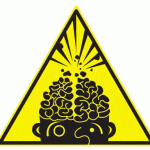 The research I have conducted on the neuroscience of situational awareness and high-risk decision making has been fascinating and extremely enlightening to me. Over the past 12 years, it has been very rewarding to take the lessons of research and apply them for the benefit of first responders. For those who have attended one of my programs, you know these lessons are always shared in friendly ways (i.e., avoiding all the heady terminology of brain science).
The research I have conducted on the neuroscience of situational awareness and high-risk decision making has been fascinating and extremely enlightening to me. Over the past 12 years, it has been very rewarding to take the lessons of research and apply them for the benefit of first responders. For those who have attended one of my programs, you know these lessons are always shared in friendly ways (i.e., avoiding all the heady terminology of brain science).
One of the findings of my research led me to the conclusion that once a commander becomes overloaded and overwhelmed, managing the mental workload can become extremely difficult and meltdowns are predictable. And, much to my dismay, it is quite easy to overload and overwhelm someone who is under stress (e.g., the incident commander).
Understanding what is happening
Simply because someone is paying attention to their environment – looking around and actively listening – does not mean they understand the meaning of what is happening. We can see things we don’t understand. And we can hear things we don’t understand. The problem is, we don’t always realize we are not understanding.
 However, it is your understanding of something that becomes your “perception” of reality. Your perception IS your reality and if it is flawed you may not know any different until true reality replaces your flawed perception. Sometimes this happens in time to avoid bad outcomes. Sometimes it doesn’t.
However, it is your understanding of something that becomes your “perception” of reality. Your perception IS your reality and if it is flawed you may not know any different until true reality replaces your flawed perception. Sometimes this happens in time to avoid bad outcomes. Sometimes it doesn’t.
In dynamically changing conditions there is a lot of information to understand. Add stress and time compression and it is easy to see how the brain can become overwhelmed trying to make sense of it all. Unfortunately, the brain has a limited capacity for how much information it can process. When information comes in faster than the brain can process, the meaning of some of the information will be lost or misunderstood.
When the incoming information is complex, it can slow down the brain’s ability to process the meaning, as well. As the processors get bogged down trying to assess the meaning of complex information, some of the new incoming information may not get processed (i.e., It will not be comprehended).
Speed and complexity
Rapid inputs, combined with complexity can quickly seize up the brain’s mental processors. Where incident scene conditions change slowly and/or the information is not complex, commanders may be able to manage the mental load without the extra challenge.
The faster the rate of change and the more complex the information (both visual and audible), the harder it can be for a commander to comprehend the meaning, sort out conflicting information and keep track of the facts.
The shocking experiment
In 2014 I created a research experiment I am now running in all of my Situational Awareness programs. The purpose of the exercise is two-fold. First, it serves as a powerful demonstration of how easy it is for someone to become overloaded and overwhelmed with information processing.
This experiment takes less than one minute. The participants are given a task that involves visual processing of information and simultaneous audible processing of information – not unlike what is required at any emergency scene.
 The experiment tests the limits of short-term memory capacity and shows how vulnerable we are to forgetting what we see and/or hear. The experiment also tests a participant’s ability to multitask. I explain to the participants that it is neurologically impossible to multitask the act of paying attention but, inevitably, there are those doubters in the room.
The experiment tests the limits of short-term memory capacity and shows how vulnerable we are to forgetting what we see and/or hear. The experiment also tests a participant’s ability to multitask. I explain to the participants that it is neurologically impossible to multitask the act of paying attention but, inevitably, there are those doubters in the room.
When the dust settles on the experiment, the results are always stunning and, quite frankly, disturbing. It seems as though the entire room has suffered a complete situational awareness meltdown. Keep in mind this is done in a classroom. There is no stress. No loud noises. No flashing lights. No screaming. No saws or fans running. No radio traffic to monitor. No personnel to account for. And yet… a complete meltdown occurs.
Suffice it to say, paying attention, understanding and predicting future outcomes in dynamically changing environments is extremely difficult.
Rich Gasaway’s Advice
 The solution to this problem might be one that’s easier said than done, especially in the early moments of an incident while staffing is sparse. So, I want to acknowledge that some of the best practices I offer may be challenging for some organizations to achieve. Nonetheless, here are some solid recommendations for managing the mental workload.
The solution to this problem might be one that’s easier said than done, especially in the early moments of an incident while staffing is sparse. So, I want to acknowledge that some of the best practices I offer may be challenging for some organizations to achieve. Nonetheless, here are some solid recommendations for managing the mental workload.
1. Prioritize the incoming information: Not all input is critical. In fact, some of the incoming information just gets in the way of what you need to be paying attention to and remembering. The good news is, you can give thought to, in advance of an emergency, what pieces of information are the most important.
2. Avoid distractions: Easier said than done, for sure. At emergency scenes there is a lot of stimuli competing for your attention. Because of instinct, your brain has “primal trip wires” that are designed to alert you to impending danger. Thus, something in your environment that is loud, or bright, or moving, and/or moving in your direction (in the early cave-dweller’s existence this might have been saber-toothed tiger lunging, for example) will capture your attention. Potential ADHD issues aside, emergency scenes offer a plethora of distractions. Keep your focus on priority issues (especially those related to safety).
3. Write stuff down: Again, depending on the environment and the task being performed, it may be difficult to write things down. However, if you are in the fixed command position there is no reason not to journal the critical information. This is especially true about apparatus on scene and crew sizes, location, tasks being performed and progress being made (or not made). If something goes awry suddenly and your stress gets elevated, your ability to remember and recall could suffer a catastrophic meltdown.
4. Repeat to remember: The more you repeat information to yourself the better your recall of the information will be. This could entail repeating information in your head and can also entail repeating radio traffic. As you repeat it back you have to cull it out of memory, say it, listen to it and then send it back into to memory for processing again. This can help you remember and recall better.
5. Get some help: This is really important. I am thoroughly convinced, based on my research, the research of countless others, my evaluation of hundreds of casualty reports and my own lived experience: Commanding a high-stress incident with multiple companies engaged in high-consequence activities, requires the mental capacity of more than one person. It is not possible for one person to keep track of all the visual and audible information being processed. This is what the experiment discussed previously, demonstrates so well.
Action Items
 1. Discuss the challenges you face with trying to process information in a dynamically changing environment.
1. Discuss the challenges you face with trying to process information in a dynamically changing environment.
2. Discuss a time when you missed (or misunderstood) radio traffic as a result of the volume of information you were processing (visual and/or audible).
3. Discuss the best practices you use for managing the mental workload at emergency incident scenes.
_____________________________________________________

If you are interested in taking your understanding of situational awareness and high-risk decision making to a higher level, check out the Situational Awareness Matters Online Academy.
CLICK HERE for details, enrollment options and pricing.
__________________________________
Share your comments on this article in the “Leave a Reply” box below. If you want to send me incident pictures, videos or have an idea you’d like me to research and write about, contact me. I really enjoy getting feedback and supportive messages from fellow first responders. It gives me the energy to work harder for you.
Thanks,

Email: Support@RichGasaway.com
Phone: 612-548-4424
SAMatters Online Academy
Facebook Fan Page: www.facebook.com/SAMatters
Twitter: @SAMatters
LinkedIn: Rich Gasaway
YouTube: SAMattersTV
iTunes: SAMatters Radio

I read your blog, it was really helpful for everyone. Really looking forward to seeing more of your blog. Really good content.